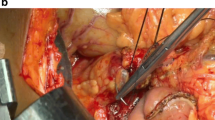Abstract
Background
The leading cause for morbidity and mortality after pancreaticoduodenectomy is a pancreatic anastomotic leak and fistula. The two most commonly performed anastomoses after pancreaticoduodenectomy are pancreaticogastrostomy (PG) and pancreaticojejunostomy (PJ). The role of standardization on outcomes after pancreaticoduodenectomy has not been sufficiently addressed.
Aim
The goal is to study the impact of a standardized technique of pancreatic anastomosis (PJ) after pancreaticoduodenectomy in a tertiary referral cancer teaching hospital.
Materials and methods
A single-institution database was analyzed over 15 years. The entire data were subdivided into two periods, viz., period A (1992 to 2001), when PG (dunking) was predominantly used, and period B (2003–2007), when a standardized technique of PJ (duct to mucosa) was employed.
Results
There were 144 pancreaticoduodenectomies performed during period A with a pancreatic fistula rate of 16%. During period B, 123 pancreaticoduodenectomies were performed with a pancreatic fistula rate of 3.2% (p < 0.0005).
Conclusions
It appears that a standardized approach to the pancreatic anastomosis and a consistent practice of a single technique can help to reduce the incidence of complications after pancreaticoduodenectomy.

Similar content being viewed by others
References
Trede M, Schwall G, Saegar H (1990) Survival after pancreaticoduodenectomy. Ann Surg 211:447–458
Cameron JL, Pitt HA, Yeo CJ, Lillemoe KD, Kaufman HS, Coleman J (1993) One hundred and forty five consecutive pancreaticoduodenectomies without mortality. Ann Surg 217:430–438
Rosenberg L, MacNeil P, Turnacioglu K (1999) Economic evaluation of the use of octreotide for prevention of complications following pancreatic resection. J Gastrointest Surg 3:225–232
Jagannath P, Shrikhande SV (2003) Current options in the diagnosis and management of Periampullary carcinoma. Ind J Surg 65:347–353
Jagannath P, Dhir V, Shrikhande SV, Shah RC, Mullerpatan P, Mohandas KM (2005) Effect of preoperative biliary stenting on immediate outcome after pancreaticoduodenectomy. Br J Surg 92:356–361
Z’graggen K, Uhl W, Friess H, Buchler MW (2002) How to do a safe pancreatic anastomosis. J Hepatobiliary Pancreat Surg 9:733–737
Kotwall CA, Maxwell JG, Brinker CC, Koch GG, Covington DL (2002) National estimates of mortality rates for radical pancreaticoduodenectomy in 25,000 patients. Ann Surg Oncol 9:847–854
Birkmeyer JD, Stukel TA, Siewers AE, Goodney PP, Wennberg DE, Lucas FL (2003) Surgeon volume and operative mortality in the United States. N Engl J Med 349:2117–2127
Bassi C, Dervenis C, Butturini G, Fingerhut A, Yeo C, Izbicki J, Neoptolemos J, Sarr M, Traverso W, Buchler MW (2005) Postoperative pancreatic fistula: An international study group (ISGPF) definition. Surgery 138:8–13
Shrikhande VN, Shrikhande SV, Shukla PJ (2004) Pancreatic Cancer: Recent Advances. In: RL Gupta (ed) Recent advances in surgery, vol. 9. Jaypee Publishing, New Delhi, pp 250–262
Friess H, Boenert M, Shrikhande SV, Berberat P, Wirtz M, Buechler M (2002) Management of Complications following Pancreaticoduodenectomy. In: Jagannath P (ed) HPB current concepts. Churchill Livingstone, New Delhi, pp 209–222
Balachandran P, Sikora SS, Raghavendra Rao RV, Kumar A, Saxena R, Kapoor VK (2004) Haemorrhagic complications of pancreaticoduodenectomy. ANZ J Surg 74:945–950
Yeo CJ, Cameron JL, Maher MM, Sauter PK, Zahurak ML, Talamini MA, Lillemoe KD, Pitt HA (1995) A prospective randomized trial of pancreaticogastrostomy versus pancreaticojejunostomy after pancreaticoduodenectomy. Ann Surg 222:580–588
Bassi C, Falconi M, Molinari E, Salvia R, Butturini G, Sartori N, Mantovani W, Pederzoli P (2005) Reconstruction by pancreaticojejunostomy versus pancreaticogastrostomy following pancreatectomy. Results of a comparative study. Ann Surg 242:767–773
Duffas JP, Suc B, Msika S, Fourtanier G, Muscari F, Hay JM, Fingerhut A, Millat B, Radovanowic A, Fagniez PL (2005) A controlled randomized multicenter trial pancreatogastrostomy or pancreatojejunostomy after pancreaticoduodenectomy. Am J Surg 189:720–729
Buchler MW, Friess H, Wagner M, Kulli C, Wagener V, Z’graggen K (2000) Pancreatic fistula after pancreatic head resection. Br J Surg 87:883–889
Kapur BM, Misra MC, Seenu V, Goel AK (1998) Pancreaticogastrostomy for reconstruction of pancreatic stump after pancreaticoduodenectomy for ampullary carcinoma. Am J Surg 176:274–278
Asopa HS, Garg M, Singhal GG, Singh L, Asopa J (2002) Pancreaticojejunostomy with invagination of spatulated pancreatic stump into a jejunal pouch. Am J Surg 183:138–141
Peng S, Mou Y, Cai X, Peng C (2002) Binding pancreaticojejunostomy is a new technique to minimize leakage. Am J Surg 183:283–285
Schlitt HJ, Schmidt U, Simunec D, Jager M, Aselmann H, Neipp M, Piso P (2002) Morbidity and mortality associated with pancreatogastrostomy and pancreatojejunostomy following partial pancreatoduodenectomy. Br J Surg 89:1245–1251
Shrikhande SV, Qureshi SS, Rajneesh N, Shukla PJ (2005) Pancreatic anastomoses after pancreaticoduodenectomy: do we need further studies? World J Surg 29:1642–1649
McKay A, Mackenzie S, Sutherland FR, Bathe OF, Doig C, Dort J, Vollmer CM Jr, Dixon E (2006) Meta-analysis of pancreaticojejunostomy versus pancreaticogastrostomy reconstruction after pancreaticoduodenectomy. Br J Surg 93:929–936
Wente MN, Shrikhande SV, Muller MW, Diener MK, Seiler CM, Friess H, Buchler MW (2007) Pancreaticojejunostomy versus pancreaticogastrostomy: systematic review and meta-analysis. Am J Surg 193:171–183
Author information
Authors and Affiliations
Corresponding author
Rights and permissions
About this article
Cite this article
Shrikhande, S.V., Barreto, G. & Shukla, P.J. Pancreatic fistula after pancreaticoduodenectomy: the impact of a standardized technique of pancreaticojejunostomy. Langenbecks Arch Surg 393, 87–91 (2008). https://doi.org/10.1007/s00423-007-0221-2
Received:
Accepted:
Published:
Issue Date:
DOI: https://doi.org/10.1007/s00423-007-0221-2




